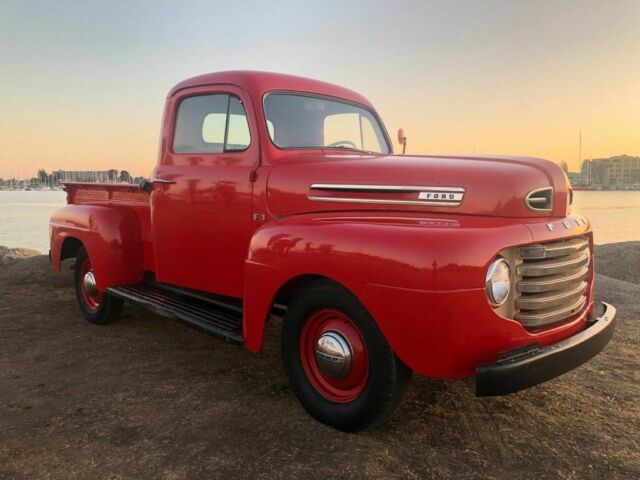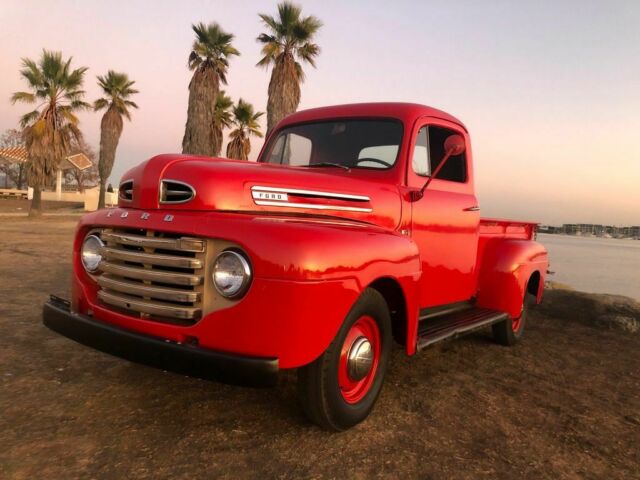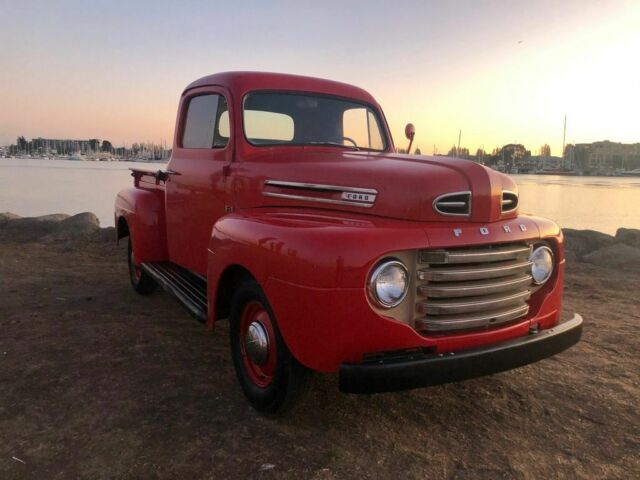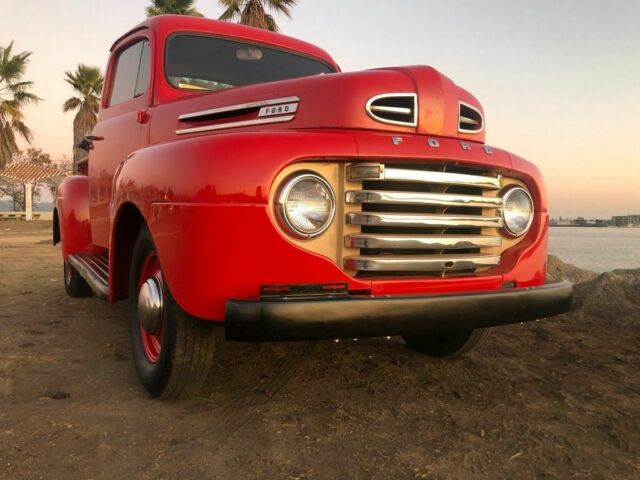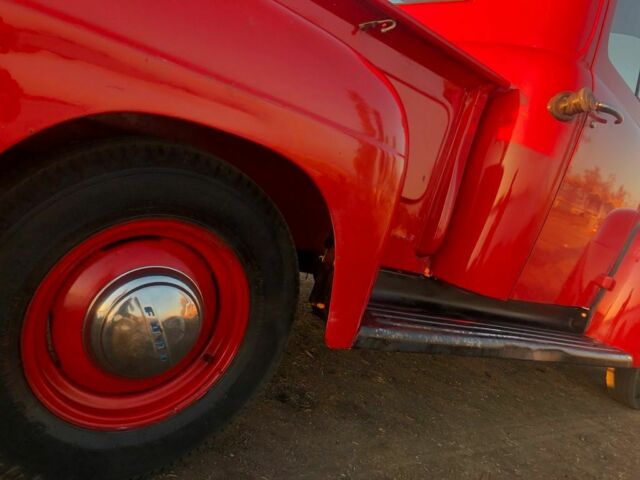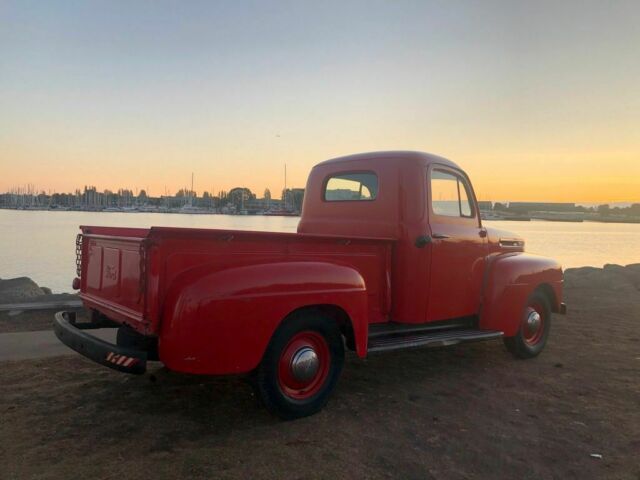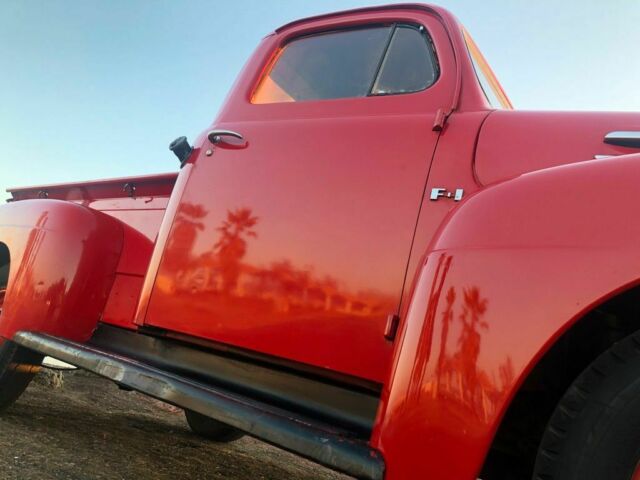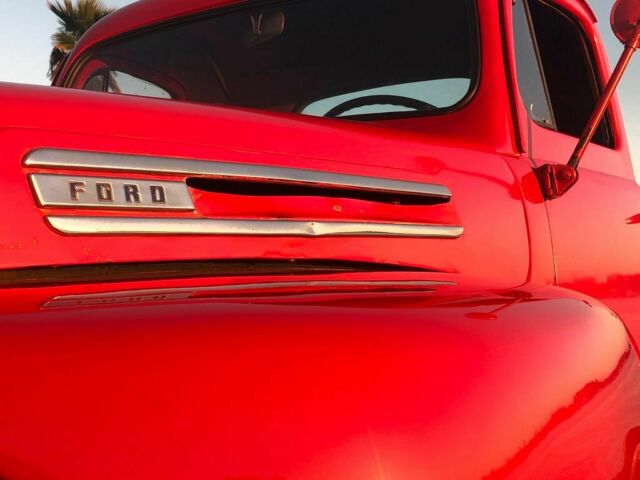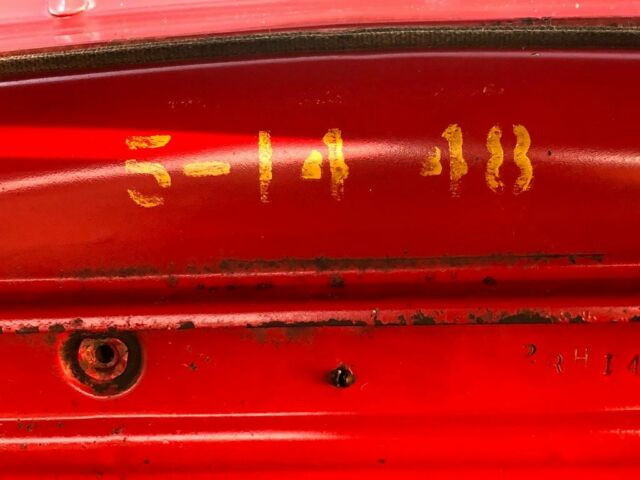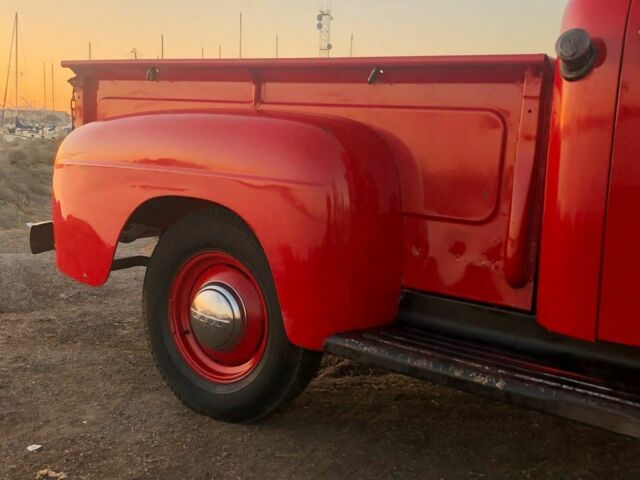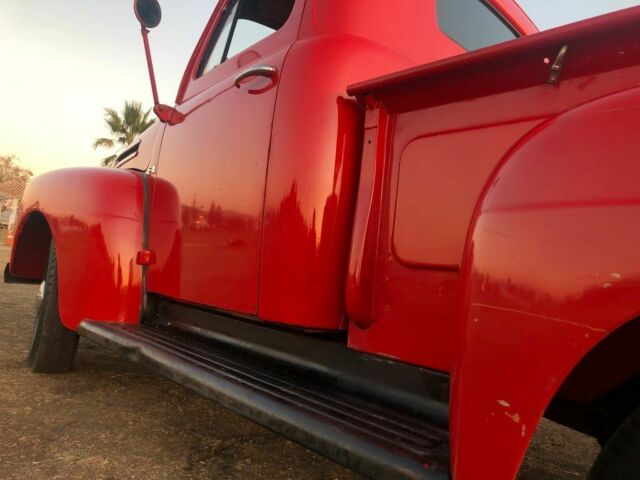1948 Ford F-1 only 56897 mi Original California Survivor in storage for decades
- Location: Oakland, California, United States
- Condition: Used
- Make: Ford
- Model: Other Pickups
- Type: Standard Cab Pickup
- Year: 1948
- Mileage: 56897
- VIN: 88rc42998
- Color: Red
- Engine size: 239 CI Flathead V8
- Number of cylinders: 8
- Fuel: Gasoline
- Transmission: Manual
- Drive type: RWD
- Interior color: Brown
- Vehicle Title: Clean
1948 Ford Other Pickups Description
1948 Ford F-1True California truck born and raisedBuilt in Richmond,CA over 7 decades agoOriginal 239cid Ford Flathead V8Never ventured more than a 13 miles radius form its birthUp for bid on a NO RESERVE auction is an original 1948 Ford F-1 pickup finished in VermilionRed. This is a true California survivor that has been apart of a large collection stored for the last 4 decades. This particular example was built in Richmond, CA at the old Ford assembly plant, located on Harbor way adjacent to the deep water Ford Channel at the entrance of Richmond’s inner harbor on the San Francisco bay. The truck has never left the the eastern shore of the bay area; being built in Richmond then was sold new 8 miles south at Bullwinkle Ford in Berkeley, CA and ultimatelyspendingthe last 71 years in Oakland, CA. The truck was originally owned for 20 years by the owner of a small produce business in Oakland's historic downtown street produce district. The truck had been seen weekly driving the same route in Oakland and was pursuedfor many years. As he did with many of the vehicles in his collection frequent stops for small talk ending with the question Would you sell it? Persistence always pays off and one day years later he acquiredit from the original owner. For the last 42 years she has been stored in a giant building with 300 plus other classic vehicles.
This first year "Bonus Built" classic has lived in the East Bay for over 7 decades 13 miles from it's birth. This is a fact that is difficult to duplicate.Ford’s legendary F-Series was first unveiled in January of 1948, Ford’s first postwar line with eight levels of trucks: F-1 for half-ton pickups, F-2 for the three-quarter ton, up to F-7 and F-8 heavy duty trucks. Base engine was a 226-cid flathead six cylinder. This example has the optional V8 Ford’s infamous flathead V8 displacing 238-cid and making 100 horsepower. Ford’s truck engines were painted red from 1948 through 1951.
Fords all-new post war vehicle (preceding the all-new 1949 Ford, Mercury, and Lincoln car lines) not only saw the start of future sales success, but the start of an easily identifiable nameplate that has evolved into the F-series nameplate Ford uses today 71 years later. Promotional people didn’t call these machines “Bonus Built” for nothing. Ford reportedly spent $1 million in 1948 the equivalentto $10 million in 2019 to give buyers more truck than ever before.Increasing driver and passenger friendliness was a main goal; the wider, taller “Million Dollar Cab” offered a “living room” feel, and its improved seat delivered “easy chair comfort”
Cosmetically this truck is 71 years old and in very nice shape. The body is quite straight with a a few minor dings here and there as well as some scratchesI really tried to capture all the imperfectionsin the numerous high definitionphotos I have included. The truck has no rust anywhere except for a small section below the tailgate. The bed is an interesting design with a normal wood slat style bed and a metal floor welded on top. After 71 years the metal floor has become thin in the bed. There are a few small cracks in the original glass. The wheels and hubcaps are original and look great. The tires hold air but are several decades old.
The interior in this truck is in awesome shape. The simplicity and originality is refreshing in this day in age we live in. All the original red paint shines great. The originalgauges are functional. The original optional drivers only sun visor is still very much present. The majority of the originalheadliner cardboard is still very much present and in good shape. This is amazing that after 71 years most of the headliner is still there. The original seat in in great shape and quite plush again after 71 years is amazing and a testament to the quality of materials combined with proper indoor storage. The original flooring is also in fantastic shape and very much present and not ripped up.
Mechanically when a motor is properly stored it makes all the difference in the world when decades later it comes time to lighting the fire. This 239 Flathead v8 has been stored properly and is runner. The motor runs strong, and shifts smooth in all gears. The truck is still a stock 6 volt setup, all of the electronics are functional. The brakes stop as they should. The truck is mechanically in good condition and doesn'tappear to have any issues. However the truck is 71 years old and been sitting for the majority of its life.
Anyone can restore a truck finding an original California survivor in red is hard to duplicate
Vin# 88RC42998
8= 19488= V8 ENGINE R=Richmond C= ½ TON TRUCK 42998= PRODUCTION SEQUENCE
54110 – MILESaveraged miles per year is 762
Showroom rivals to the GM Advanced Design trucks. Ford’s first all-new post war vehicles (preceding the all new 1949 Ford, Mercury, and Lincoln car lines) not only saw the start of future sales success, but also the start of an easily identifiable nameplate that has evolved into the F-series Ford uses today.
Unveiled in January of 1948, Ford’s new postwar pickup line started off with the F-1 half ton. Ford motor company spent over $1 million promoting the all “Bonus Built” F series model’s giving buyers more truck for their money increasing driver and passenger friendliness was the main goal; wider, taller “Million Dollar Cab” offering a “living-room feel, and its improved seat delivered “easy chair comfort”
A floor-shifted three-speed transmission was standard on te half-ton F1 trucks, with a four-speed transmission standard on bigger trucks, and optional on he half-ton trucks.
Aside from the drivetrain and the 114” wheelbase, Ford’s “Bonus-Built” trucks were completely different from the car-based trucks they replaced. All-new front sheet metal featured integrated headlights, a one piece windshield which increased visibility, and wider, longer and taller cabs.
Increased interior dimensions started with a seven-inch stretch in cab width. By positioning the door hinges three inches farther forward, easier entry was obtained.
The steering wheel was more horizontal and mounted closer to the driver, and a three-person bench seat moved back and forward on roller bearings. To help isolate frame flex, rubber mounts were used between cab and frame
Early Ford F-1 models had a 6-1/2 foot cargo box with an all-steel floor, giving 45-cubic feet of load space . Ford F-2 and F-3 models fitted with an eight -foot bed. As with common in the day, Ford trucks left the factory with a left only tail light.
114 in wheel base
OPTIONAL 100 HORSEPOWER 239 2BBL FLATHEAD V8
NO RESERVE THIS ITEM WILL SELL TO THE FINAL BIDDER!This listing includes well over 150 detailed photos in various lighting and the vehicle has been described as descriptive as possible. If there is anything that is unclear or additional information is needed please don't hesitate to ask. Please ask any questions before bidding.Please only bid with the intention to own. Bidding then canceling for "entering the wrong amount" will get you blocked from further bidding. Thanks and Good Luck**ONLY BID WITH INTENTIONS TO PAY FOR AND OWN THIS Truck**
What is a true California car?
This truck is a true California original built 71 years ago just 13 miles away at the historic Ford Motor Company Assembly Plant in Richmond, California. The Richmond Assembly plant built during the depression in 1930 was the largest assembly plant on the West Coast with nearly 500,000 square feet.
To ensure that America prepared for total war during World War II President Franklin D. Roosevelt banned the production of civilian of civilian automobiles. The Richmond Ford Assembly Plant switched to assembling Jeeps and putting the finishing touches on tanks, half track armored personal carriers, armored cars and other military vehicles destined for the Pacific Theater
By July 1942, military combat vehicles began flowing into the Richmond Ford plant to get final processing before being transported out the deep-water channel to the war zones. The "Richmond Tank Depot" (only one of the Tank Depots in the country) as the Ford plant was then called, helped keep American fighting men supplied with up-to-the-minute improvements in their battle equipment. Approximately 49,000 jeeps were assembled, and 91,000 other military vehicles were processed here
After the war, the devastation to the local economy as a result of the closing of the Richmond Shipyards would have been crippling had it not been for the continued production of the Ford Plant. The last Ford was assembled in February 1953, with the plant being closed in 1956 and production transferred to the San Jose Assembly Plant to accommodate increased productivity demands.
The plant was featured in the movie "Tucker: The Man and His Dream." Principal photography started with first unit shooting on April 13, 1987 in the Ford Motor Company Assembly Plant in Richmond, California.
WE CAN HELP YOU SHIP YOUR CLASSIC TO JUST ABOUT ANYWHERE IN THE WORLD FOR A LOT LESS THAN YOU MIGHT THINK
Classic Car Imports from the USA
Video will open in a new window
Using the mobile app? Copy this link into your browser:TERMS OF SALE
I RESERVE THE RIGHT TO:
- Obtain and verify the registered information of all users who bid on this auction
- Cancel any and all bids at my discretion or end the auction early if necessary
- Bidders Age: You must be 18 years of age or older to bid
- Special eBay Bid Retraction Rules: Please read eBay's "Retracting a Bid"
- Your bid constitutes a legally binding contact to purchase this vehicle. Please read eBay's User Agreement
- If you place a bid before the last 12 hour period of the auction, you may retract that bid before the last 12 hour period but only for exception circumstances. You will not be allowed to retract that bid during the last 2 hour period of the auction.
- If you place a bid during the last 12 hour period of the auction, you will be allowed to retract the bid for exceptional circumstances but only if you do so within one hour after placing the bid.
- Buyer will need to arrange funds or financing before pickup or shipment.
- INSPECTION: I have done my best to disclose all information known about this vehicle for auction. I welcome a buyers inspections. If you plan to have a buyer's inspection, please make sure you inspect the vehicle prior to the auction ending. Inspection fees, if any, are buyers responsibility.
- REPRESENTATIONS AND WARRANTIES MADE BY SELLER: This vehicle is being sold "as is". No representations or warranties are made by seller, nor are any representationsor warranties relied upon by bidders in making bids.
- TITLE INFORMATION: If payment is made by cashier's or personal check we will hold all titles for 10 days or until funds have cleared.
- All shipping charges and arrangements are buyer's responsibility. I will make vehicle available to third party shipping company hired by buyer but will not be responsible in any way for claims arising from shipping damage.
- Licensed carriers are generally insured for $3,000,000.00. We assume no responsibility for damages incurred after the vehicle leaves our location. Any claimsor other communication regarding shipment of vehicles will be between you and the shipper, not with seller.
- The amount of time it takes for delivery is dependent on the carrier. Verify with the shipper for an estimated time of arrive to be sure.
- I will contact the successful high bidder by email after the auction closes.
- Successful high bidder MUST communicate with seller through eBay within 24 hours of the auction ending to make arrangements to complete their transaction. If we cannot confirm your intention to buy or the sale is not completed within 5 days, we reserve the right to relist this vehicles or sell to any other qualified buyer.
- In order to secure bidon vehicle, successful bidder (buyer) must within 24 hours of bid closing send to seller a non-refundable deposit in the amount of $500.00 via PayPal. Within 72 hours of bid closing, buyer must send balance of funds by bank wire transfer, cash in person, or bank certified funds to seller.
WE CAN HELP YOU GET THIS ONE OF A KIND VEHICLE SHIPPED TO JUST ABOUT ANYWHERE IN THE WORLD FOR LESS THAN YOU THINK CLICK ON THE ARROW TO SEE THE SIMPLE PROCESS
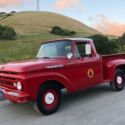 1962 Ford F-100 original CDF paint 39k mi California survivor stored for decades
1962 Ford F-100 original CDF paint 39k mi California survivor stored for decades
Mileage: 39166
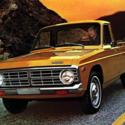 1972 Ford Courier original California Barn Find time capsule n storage for years
1972 Ford Courier original California Barn Find time capsule n storage for years
Mileage: 43088
 1948 Ford Super DeLuxe Coupe, Original Survivor, Hot Rod
1948 Ford Super DeLuxe Coupe, Original Survivor, Hot Rod
Mileage: 18,386
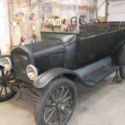 1924 Ford Model T Touring Car REAL SURVIVOR!! Just out of Long Storage
1924 Ford Model T Touring Car REAL SURVIVOR!! Just out of Long Storage
Mileage: 999,999
 1990 Ford 5.0 LX Senior owned California Barn Find in storage for years New Top
1990 Ford 5.0 LX Senior owned California Barn Find in storage for years New Top
Mileage: 56990
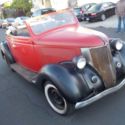 1936 Ford Cabriolet,Back after 54 years in storage, California Ragtop Convert-
1936 Ford Cabriolet,Back after 54 years in storage, California Ragtop Convert-
Mileage: 77,777
 1924 Ford Model T Touring Car REAL SURVIVOR!! Long Storage RELISTED
1924 Ford Model T Touring Car REAL SURVIVOR!! Long Storage RELISTED
Mileage: 999,999
 1989 FORD BRONCO XLT 61K Original-CALIFORNIA SURVIVOR--RARE! Must See
1989 FORD BRONCO XLT 61K Original-CALIFORNIA SURVIVOR--RARE! Must See
Mileage: 61,800
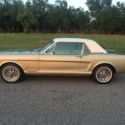 1966 Ford Mustang GT Survivor 2nd Owner, TRUE GARAGE FIND- IN STORAGE SINCE 1978
1966 Ford Mustang GT Survivor 2nd Owner, TRUE GARAGE FIND- IN STORAGE SINCE 1978
Mileage: 94000
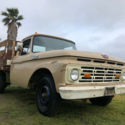 1964 Ford F-350 Flatbed Original California Survivor 292 Y block, Dana 70
1964 Ford F-350 Flatbed Original California Survivor 292 Y block, Dana 70
Mileage: 7032
